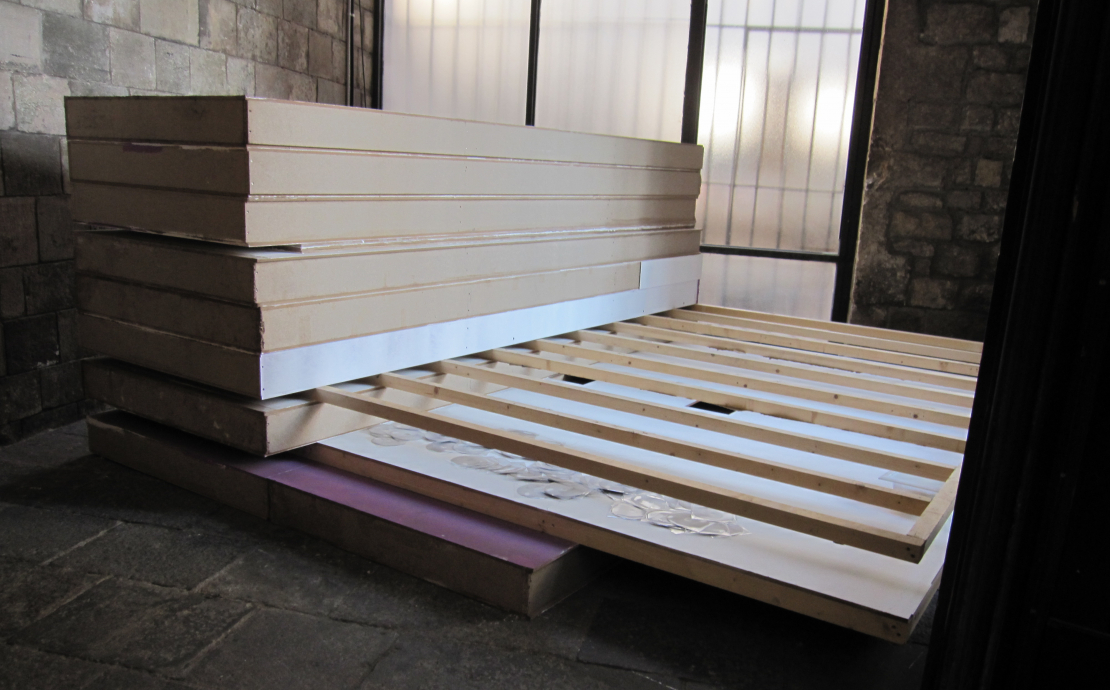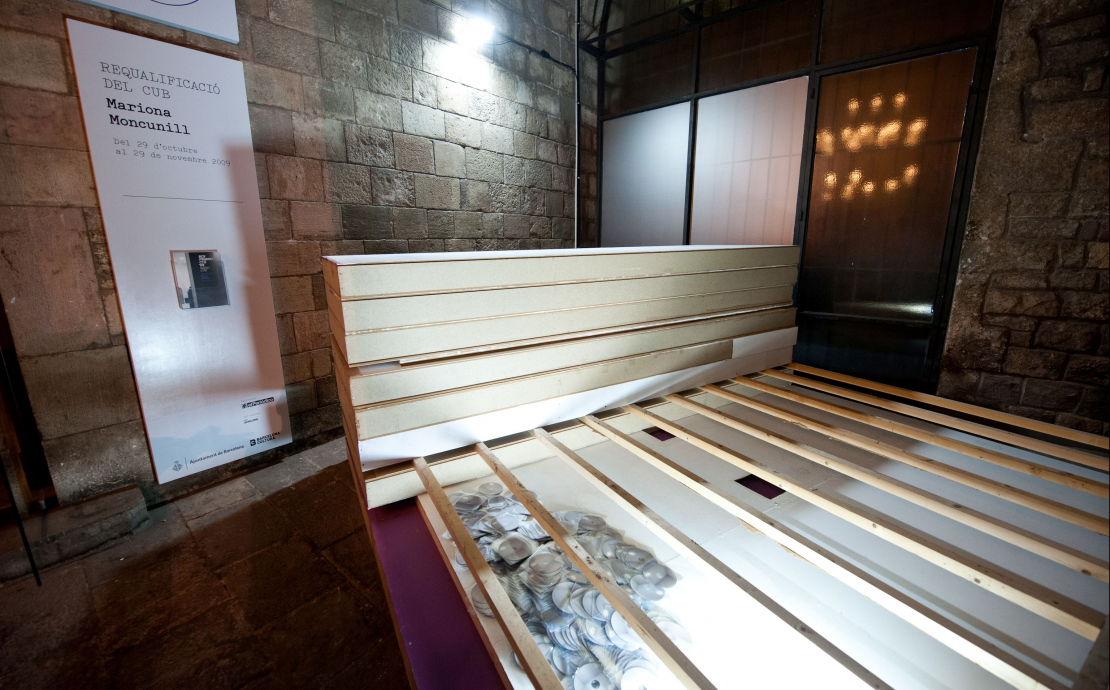Requalication of the cube
Mariona Moncunill
Requalifying the Cube
From 29 october until 29 november
Criticism levelled at material and institutional exhibition conditions has been a constant in contemporary art since the 1960s. A room’s walls, artists’ salaries (if they actually get paid), the history surrounding a venue and the ideological and even atmospheric conditions have been subject to systematic deconstruction. Today, the application of procedures that to some extent pursue that practice takes on a different meaning. Even an attempt to avoid objectuality has become an excuse to produce new objects!
The disassembly operation that Mariona Moncunill applies to the Cube at the entrance to La Capella could be positioned within these coordinates. But the matter becomes a little more complicated if we consider that this structure – the Cube – is also the container offered within the context of a public call for submissions, from which four young artists were selected. The series of exhibitions in the Cube becomes temporarily interrupted by the decision to disassemble it. The container is presented to onlookers as a sum of discrete materials. And, finally, it makes us think that there is nothing to see during the period when this artist is, supposedly, exhibiting. So, reactions to the work will have to be considered as a replacement for the work itself.
INTERVIEW WITH MARIONA MONCUNILL
Right now, as we hold this interview, your project is still somewhat undefined. It hasn’t been fully finalised. Even though the idea of disassembling the Cube used to host exhibitions by artists in the Espai Cub programme before and after “Requalifying the Cube” seems to fall within a practice of institutional criticism; even though the procedure is in place; even though the content of the work is free from content; you are still considering some last-minute formal choices. Doubts about the fact that the idea itself will not be very attractive once executed?
Even though it may not appear to be the case for projects of this type, the execution of the work, that is to say the final formulation and production detail, is what gives the idea credibility. It is destroyed by excess or betrayed by a lack of radicality. Balance is essential, not to make the idea attractive, which it can be in spite of the execution, but to ensure that it does not lose either conviction or, in particular, nuance. With apparently simple executions like this one, it is easy to emphasise nuances that you don’t want to stress. In fact, one of my concerns is to avoid making too much of the role of that practice of institutional criticism that you’re referring to. I’m not particularly interested in the discourse of institutional criticism, even though it may be indissociable from an action like transforming the exhibition space, which, in addition, is a white cube, into materials for constructing a sculpture. The exhibition space does not worry me. Rather, it fascinates me. And not because of the relationship with the institution, since any transgression referring to the institution would be easy. It fascinates me because of the relationship with the user (we show that it exists, if only for a moment) or with artists themselves.
To what extent could it be said that you work with an artistic practice as a raw material and not with specific materials or situations?
That, to a great extent, is the case. In any event, this is the place that the practice of institutional criticism we’re talking about actually occupies. But, above all, there is a practice that appeals to the critical and analytical spirit of the user, the reader, the onlooker and the artist in relation to conventions that are both narrative and consecrating, which we inevitably find ourselves immersed in. It is a practice that was especially strong in the 1960s, though it is still current today. I would say that there are many artists who are still fascinated by “rules of the game” capable of generating huge creative potential.
Disassembling the Cube, with the four walls turned into discrete units might appear to be an iconoclastic remark: a negation of the abundance of images. Do you think that your intervention echoes that concern?
No, I don’t. But I am interested in the fact that it raises that doubt. Iconoclasty is only there as a passing reference because, after all, I’m creating a new image by transforming the walls, which were only space and architecture, into the exhibited work. I am transferring them to the category of an image in the same way as William Anastasi did when he took photos of the empty walls of a gallery, and Reinhard Mucha did when he exhibited empty showcases as if they were sculptures.
Do you also think that the white cube is no longer the symbol of an exhibition venue’s neutrality? I would say that it’s time to start deconstructing the black box or even the liquid forms that characterise the latest artistic container constructions.
Even though the debate about the white cube has been had, the consequences still remain. A white cube acts as a paradigm for deconstructing other exhibition contexts. That’s why any exhibition space, literally a white cube (in Espai Cub’s case it is a physical cube and not a metaphorical one), is like a gift when it comes to holding this debate. Though not only in relation to the neutrality of the exhibition space that Brian O’Doherty dismembered, but also in relation to the container of meaning, in a general sense, and to the medium, whether white, black or liquid.
In fact, I would answer your question with another question: why is it no longer a symbol? The problem is that for most people the debate has never been had, and the exhibition space, whether a white cube, a black box, the Internet or the street, as a paradigm continues to be useful when bringing many other discourse generators and containers into question.
But there’s something else hidden behind this Cube. This space had a key role in the terms and conditions of the call for submissions, since they explicitly said that projects should take the fact that they would be exhibited inside it into consideration. Therefore, we could also talk about competitions and their terms and conditions, as well as the institution’s complicity in terms of desecrating them.
When the Cube is reassembled for the next exhibition, will your work disappear? Or will it remain permanently inscribed in the materials of the white walls, irrespective of what might happen in the Cube in the future, whether the walls are assembled or disassembled?
That question could be one of the potential subtitles of the project.
Collaborate
Sponsor
*Photo 1 and video, courtesy of the artist
*Photo 2: by Pep Herrero




